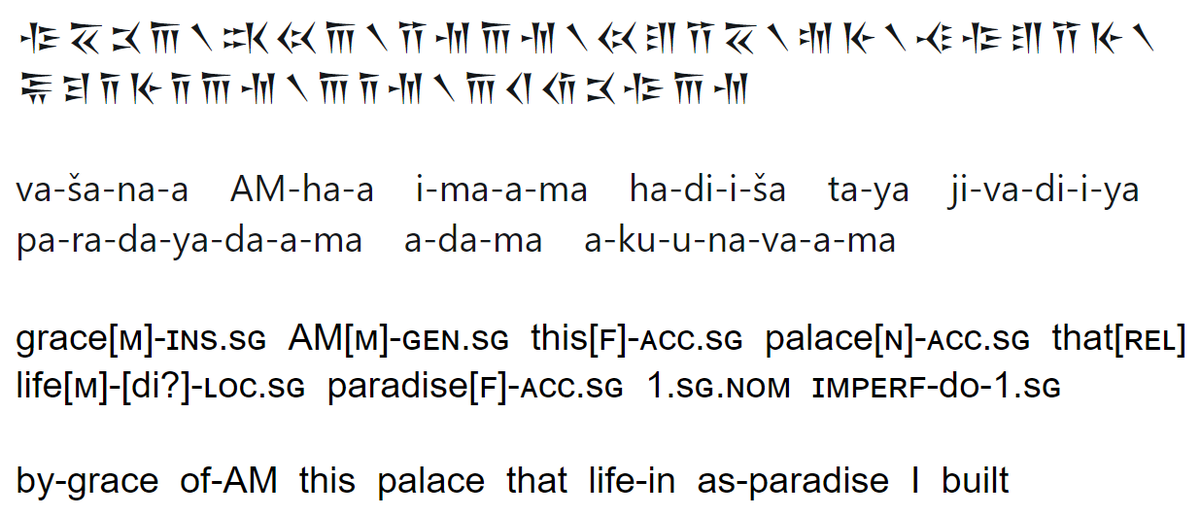Elamite word of the day!
Achæmenid #Elamite 𒁇𒋼𒌨 bar-te-taš ('storage facility for (royal??) commodities') — loan from (late) Old Persian *𝘱𝘢𝘳𝘥ē𝘥𝘢 with -š suffixed as is often seen in nominal loans from Old Persian.
Old Persian *𝘱𝘢𝘳𝘥ē𝘥𝘢 < *𝘱𝘢𝘳𝘪𝘥𝘢𝘪𝘥𝘢 ... https://twitter.com/DannyBate4/status/1295815175195504642
Achæmenid #Elamite 𒁇𒋼𒌨 bar-te-taš ('storage facility for (royal??) commodities') — loan from (late) Old Persian *𝘱𝘢𝘳𝘥ē𝘥𝘢 with -š suffixed as is often seen in nominal loans from Old Persian.
Old Persian *𝘱𝘢𝘳𝘥ē𝘥𝘢 < *𝘱𝘢𝘳𝘪𝘥𝘢𝘪𝘥𝘢 ... https://twitter.com/DannyBate4/status/1295815175195504642
... isn't directly attested anywhere, but what does survive is an attempt to write down an archaic form of the word as 𐎱𐎼𐎭𐎹𐎭 pa-ra-da-ya-da- 𝘱𝘢𝘳𝘪𝘥𝘢𝘺𝘢𝘥𝘢- in a few inscriptions of Artaxerxes II (reign: 404-358 ʙᴄ) at his palace in Susa. The emperor acknowledges ...
... Ahuramazda's grace in building his palace (a paradise), and asks for protection from Him and from the deities Anāhitā and Miθra.
𝘣𝘺 𝘵𝘩𝘦 𝘨𝘳𝘢𝘤𝘦 𝘰𝘧 𝘈𝘩𝘶𝘳𝘢𝘮𝘢𝘻𝘥𝘢, 𝘐 𝘣𝘶𝘪𝘭𝘵 𝘵𝘩𝘪𝘴 𝘱𝘢𝘭𝘢𝘤𝘦 𝘪𝘯 𝘮𝘺 𝘭𝘪𝘧𝘦𝘵𝘪𝘮𝘦 𝘢𝘴 𝘢 𝘱𝘢𝘳𝘢𝘥𝘪𝘴𝘦
𝘣𝘺 𝘵𝘩𝘦 𝘨𝘳𝘢𝘤𝘦 𝘰𝘧 𝘈𝘩𝘶𝘳𝘢𝘮𝘢𝘻𝘥𝘢, 𝘐 𝘣𝘶𝘪𝘭𝘵 𝘵𝘩𝘪𝘴 𝘱𝘢𝘭𝘢𝘤𝘦 𝘪𝘯 𝘮𝘺 𝘭𝘪𝘧𝘦𝘵𝘪𝘮𝘦 𝘢𝘴 𝘢 𝘱𝘢𝘳𝘢𝘥𝘪𝘴𝘦
𐎺𐏁𐎴𐎠𐏐𐏈𐏃𐎠𐏐𐎡𐎶𐎠𐎶𐏐𐏃𐎮𐎡𐏁𐏐𐎫𐎹𐏐𐎪𐎺𐎮𐎡𐎹𐏐𐎱𐎼𐎭𐎹𐎭𐎠𐎶𐏐𐎠𐎭𐎶𐏐𐎠𐎤𐎢𐎴𐎺𐎠𐎶
vašnā A[hura]m[azda]hā imām hadiš tya jivadiy paradayadām adam akunavām
This attested form, 𝘱𝘢𝘳𝘢𝘥𝘢𝘺𝘢𝘥𝘢- (-𝘢𝘮 for the accusative), seems to be at odds with cognates in ...
vašnā A[hura]m[azda]hā imām hadiš tya jivadiy paradayadām adam akunavām
This attested form, 𝘱𝘢𝘳𝘢𝘥𝘢𝘺𝘢𝘥𝘢- (-𝘢𝘮 for the accusative), seems to be at odds with cognates in ...
... other Iranic languages, including Avestan 𝘱𝘢𝘪𝘳𝘪-𝘥𝘢ē𝘻𝘢 and Sogdian prδyz 𝘱𝘢𝘳δē𝘻. The Avestan form, in particular, seems to lead back to a Proto-Iranic *pari-dái̯ĵa- ('that which is walled around') where this *dái̯ĵa- also agrees with Sanskrit 𝘥ḗ𝘩𝘢- ...
... (< Proto-Indo-Iranian *dái̯ĵʰa)!
Herein, the second vowel in Elamite 𝘣𝘢𝘳𝘵𝘦𝘵𝘢š tells us what was actually going on. Proto-Iranic *pari-dái̯ĵa- gave Old Persian *𝘱𝘢𝘳𝘪-𝘥𝘢𝘪𝘥𝘢- (𝘫̂ and 𝘥 regularly merge in (Old) Persian), which would have been written ...
Herein, the second vowel in Elamite 𝘣𝘢𝘳𝘵𝘦𝘵𝘢š tells us what was actually going on. Proto-Iranic *pari-dái̯ĵa- gave Old Persian *𝘱𝘢𝘳𝘪-𝘥𝘢𝘪𝘥𝘢- (𝘫̂ and 𝘥 regularly merge in (Old) Persian), which would have been written ...
... 𐎱𐎼𐎡𐎭𐎡𐎭 pa-ra-i-da-i-da- or 𐎱𐎼𐎭𐎡𐎭 pa-ra-da-i-da-. However, by late Old Persian, the historical diphthong *𝘢𝘪 had simplified to *ē as had happened in Sanskrit, and will happen later in Sogdian, Sarmatian (pre-Ossetic), pre-Kurdish ... pretty much everywhere.
This spoken form with *ē, i.e., *𝘱𝘢𝘳𝘪𝘥ē𝘥𝘢- or *𝘱𝘢𝘳𝘥ē𝘥𝘢- is what the Elamites recorded as 𝘣𝘢𝘳𝘵𝘦𝘵𝘢š. [In fact, had a native Middle Persian form existed, it would have looked much like this, *𝘱𝘢𝘳𝘥ē𝘥.]
But the scribes for Artaxerxes II probably didn't ...
But the scribes for Artaxerxes II probably didn't ...
... want this lowly spoken form inscribed on His Majesty's paradise, and so artificially tried to archaicize the spelling by replacing *ē by *aya, whence 𝘱𝘢𝘳𝘢𝘥𝘢𝘺𝘢𝘥𝘢-!
Cool how much a simple loanword in Elamite and a couple frozen cognates in Avestan and Sanskrit ...
Cool how much a simple loanword in Elamite and a couple frozen cognates in Avestan and Sanskrit ...
... can tell us about the changing speech habits of Achæmenid Persia and the socio-prestige implications thereof.
Such errors — both scribal and grammatical — and attempts at archicization abound in late Achæmenid Persian, forseeing some of the linguistic changes that we ...
Such errors — both scribal and grammatical — and attempts at archicization abound in late Achæmenid Persian, forseeing some of the linguistic changes that we ...
... verify in later forms of the language. In fact, the sentence glossed above has an example of such a mistake in agreement!
Look at the gloss (pictured) and note the determiner phrase 𝘪𝘮ā𝘮 𝘩𝘢𝘥𝘪š is ungrammatical! The feminine demonstrative 𝘪𝘮ā𝘮 ('this') has been ...
Look at the gloss (pictured) and note the determiner phrase 𝘪𝘮ā𝘮 𝘩𝘢𝘥𝘪š is ungrammatical! The feminine demonstrative 𝘪𝘮ā𝘮 ('this') has been ...
... made to attach to a neuter noun 𝘩𝘢𝘥𝘪š ('palace') — perhaps owing to the native dialect of the scribe having lost (or in the process of losing, at any rate) gender-agreement, something we know does indeed happen in the evolution of Persian.
The related modern Persian forms (𝘱ā𝘭ē𝘻, 𝘱𝘢𝘳𝘥ē𝘴) are all loans from north-western Iranic languages (cf. Kurdish 𝘱𝘦𝘳ê𝘻, 𝘱𝘢𝘳ê𝘻), which we can tell by the appearance of 𝘻 ~ 𝘴. As mentioned before, in native Persian, that /z/ would have merged with 𝘥 long ago.

 Read on Twitter
Read on Twitter


